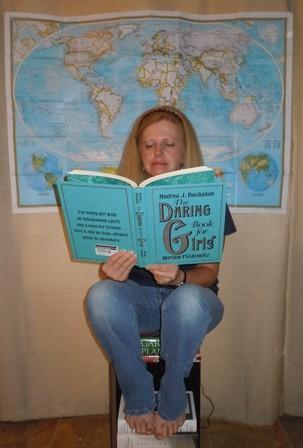Cheryl Hughes: Forrest Bathing
On Saturday, I cut down a Bradford pear tree with my pruning saw. The tree wasn’t one I set out. It was one that sprung up on its own in the little grove of trees behind my house. The tree had several thorns, like the wild version often does. I let it live there way past its welcome. I kept meaning to ask Garey to dig it up with his backhoe, because of the massive number of roots and sprouts the wild trees have, but the only time I thought about it was when he had the backhoe out working on another project, and I didn’t want to bother him.
I decided to take measures into my own hands, sawing off the limbs one at a time until l was left with just the tree trunk. Sawing the tree off next to the ground took some work, but I finally reached my goal, tossing limbs and trunk into a pile to be drug off and burned at a later date.
I had two thoughts as I worked at the grueling task of sawing through a tree trunk with a pruning saw: I have a new respect for beavers, who literally chew trees down with their teeth; and why did I never go through with my intention of asking my brother, Carl, to teach me how to run a chain saw? (Garey can operate a chainsaw, but he won’t teach me, because he’s afraid I’ll get distracted and hurt myself.)
I spent the rest of Saturday working outside, pruning trees and weeding my herb bed. It was a very fulfilling day. On the way across the yard, I remembered a term I heard earlier in the week: Forrest Bathing. The official term is Shinrin-Yoku. Developed in Japan in the 1980s, Forrest Bathing has become a cornerstone of preventative health care and healing in Japanese medicine (learn.eartheasy.com).
You can sign up for Forrest Bathing classes in many US states, taught by trained and certified teachers. There are several videos of Guides taking Students through “mindful” walks through the woods. The students are encouraged to touch tree leaves, wade in streams, and throw small stones in creeks, using all five senses to connect with their environment and clear their minds. The students pay upwards of $100 per hour for the experience.
I plan on retiring in the fall, so maybe I should think about becoming a Forrest Bathing guide for a little side income. Since I grew up in the woods—my father ran a sawmill—and we have a farm, complete with trees and a creek, I would be good at it. I enjoy a walk through the woods and a wade in a creek. I could even diversify. I could offer Extreme Forrest Bathing. Students could clear underbrush, pile it on a wagon, pulled by a team of mules, and haul it away to be burned. Garey has been wanting some errant tree roots, left behind after he cleared some land, picked up. I don’t think he would be opposed to people paying him $100 per hour to pick all that up for him. Heck, he would probably haul it off himself, no charge to my business.
Come to think of it, I could offer Garden Bathing. Students could plant my vegetable garden, set out sweet potato plants, and tend my Zinnias. Of course, I would also offer every student a chance at learning to hoe. I would remind them to be mindful as they were chopping up weeds. I would be willing to teach those skills for $100 per student, per hour.
The possibilities are endless. I’m really looking forward to retirement!



























